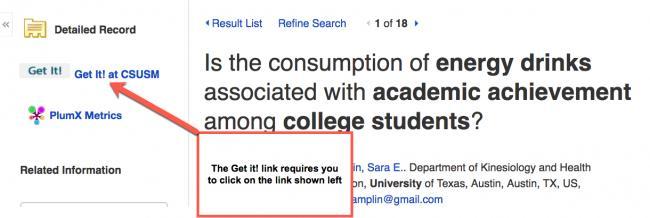-
Go to CSUSM University Library’s website: https://biblio.csusm.edu
-
Click on Most Popular
-
Click on the first database, Academic Search Premier.
-
If you are off-campus you will be asked to login.
-
You will be taken to Academic Search Premier. Click on Advanced Search to be taken to a screen where you can easily combine keywords.
-
You are now at the Advanced Search Page.
-
This is where you will combine different keywords. Don’t get frustrated if your first search doesn’t work. Be willing to try different combinations of words.
-
To demonstrate how this works let’s pretend you are doing research on whether energy drinks help college students do better in school. We’ll start by searching for newspapers and magazine articles since it is helpful to understand your topic by doing background research first.
-
Let’s first start with a single keyword. How many results do you get when you search for:
-
Energy drinks
-
-
That’s a lot of results. 5,486! And a whole bunch of them aren’t useful to us.
-
Now let’s try adding a second concept so that we can narrow down the results that we get. Add in the concept college students to see how many results you get. It’s down to 214.
-
You can see that combining two terms (college students AND energy drinks) returns fewer results than if you only search one term. Now let’s try to narrow the number of results even more to only Magazines and Newspapers. (Look at the arrows below for how to do this).
-
As shown in the image below this narrows down your results to 25 magazines and newspapers. Look at how quickly we were able to get down to only 25! We started with X number of results, and very quickly narrowed down our results to ones that were more relevant to our needs. This is how you can become a more strategic and efficient searcher.
-
Note that this icon
means it is a magazine article and this icon
means it is a newspaper article.
-
Once you feel like you have an adequate amount of background research and are armed with an understanding of your topic and a list of keywords you can use in your searches you can move on to look for Scholarly (Peer-Reviewed) Journal Articles.
-
To do this, click on New Search.
-
-
This will take you back to Advanced Search where you can enter your keywords again. To search exclusively for Scholarly (Peer-Reviewed) Journal articles you can click on the Scholarly (Peer Reviewed) Journals box, shown with the arrow above.
-
Next we’ll discuss how to access an article in full once you found one that you would like to read.
-
There are different links that you may encounter in our databases which allow you to read the article in full, such as Get it! at CSUSM, PDF Full Text, and HTML Full Text.
-
To demonstrate this, a search for an article is shown in the image below.
-
Arrows on the image point out two of the possible links you might encounter: Get it! at CSUSM and PDF Full Text
-
-
If your article shows a Get it! at CSUSM link follow these steps below. If you need PDF Full Text directions scroll down to the next step.
From the article entry OR from the list of article results: Click on the Get it! at CSUSM link. Note: This is a three click process. 
-
You will now be directed to the CSUSM library catalog.
-
Our system works to locate a database that will provide you access to a full text copy of your article (example shown in image below).
-
Note: occasionally there is NO FULL TEXT available. If so, you can request the full text article via Interlibrary Loan.
-
You will see "Full Text Available at:” besides the databases that provide full text to the articles.
-
Make your second click on the database link provided. You will be taken to an article entry in the named database.
-
-
From the named database article entry, locate a PDF Full text icon. Click three is on the PDF icon to download a copy of the article in full text. Congratulations, you now have the full text of your desired article.
-
If your article shows a PDF Full Text link follow the steps below.
-
From the article entry OR from the list of article results: Click on the PDF Full Text link. This will download a PDF full text copy of the article for your use.
-
-
A second method of obtaining the Full text of the PDF is to click on the title of the article. You will see the PDF Full Text link on the left-hand side.
-
Now it’s your turn. Using your own keywords this time, follow the steps listed in this guide to find materials on your GEW topic.
Subjects
